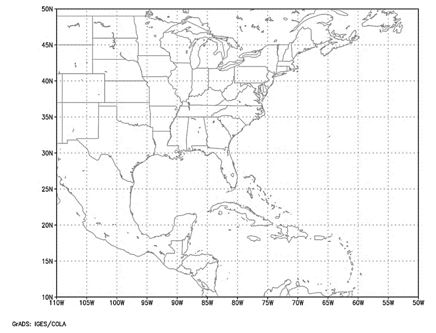Synoptic patterns associated with the seasonal behavior of cold fronts in Cuba
Main Article Content
Abstract
The present investigation consists of a climatological and synoptic study on the cold fronts that affected Cuba in the seasons between 1950 – 1951 and 2014 – 2015, grouped in the quarters October – November – December and January – February – March; these systems were stratified according to their classification in types and intensities, which contributes to the development of a seasonal forecasting method for the winter season. The synoptic patterns of the different variables studied (sea level pressure, geopotential height at different levels of the troposphere, wind field at low, medium and high levels and the thermal field at 850 hPa level) were obtained, grouped according to the impact of cold fronts on the Cuban archipelago in the selected quarters. The significant elements between these tropospheric patterns were also determined through the statistical parameter Z, which would allow them to be differentiated. In the case of classic cold fronts, a greater frequency is evident and the results are closely related to similar studies of extratropical cyclone; the reverse fronts presented a different behavior, where the patterns point to favor a better structure of the high migratory pressures. On the other hand, the frequency of the secondary and strong fronts is greater in the quarters of low behavior, and the weak and moderate fronts appear similar to the classic fronts in general.
Downloads
Article Details

This work is licensed under a Creative Commons Attribution-NonCommercial 4.0 International License.
Those authors who have publications with this journal accept the following terms of the License Attribution-NonCommercial 4.0 International (CC BY-NC 4.0):
You are free to:
- Share — copy and redistribute the material in any medium or format
- Adapt — remix, transform, and build upon the material
The licensor cannot revoke these freedoms as long as you follow the license terms.
Under the following terms:
- Attribution — You must give appropriate credit, provide a link to the license, and indicate if changes were made. You may do so in any reasonable manner, but not in any way that suggests the licensor endorses you or your use.
- NonCommercial — You may not use the material for commercial purposes.
- No additional restrictions — You may not apply legal terms or technological measures that legally restrict others from doing anything the license permits.
The journal is not responsible for the opinions and concepts expressed in the works, they are the sole responsibility of the authors. The Editor, with the assistance of the Editorial Committee, reserves the right to suggest or request advisable or necessary modifications. They are accepted to publish original scientific papers, research results of interest that have not been published or sent to another journal for the same purpose.
The mention of trademarks of equipment, instruments or specific materials is for identification purposes, and there is no promotional commitment in relation to them, neither by the authors nor by the publisher.
References
DiMego, G., Bosart, L., y Endersen, W. (1976). An Axamination of the Frequency and Mean Conditions Surrounding Frontal Incursions into the Gulf of Mexico and Caribbean Sea. Monthly Weather Review Vol. 104, 709-718.
Espinosa, D. (2018). Comportamiento y variabilidad de los sistemas invernales que afectan a Cuba. Trabajo de Diploma. La Habana, Cuba.
Ferry, N. (2010). Previsión meteorológica estacional: Los servicios de Monitorización del Océano de GMES ayudan a mejorar los servicios meteorológicos. Historias de éxito, 57-61.
González, C. (1999). Climatología de los frentes fríos que han afectado a Cuba desde 1916-1917 hasta 1996-1997. Revista Cubana de Meteorología Vol. 6 No. 1, 15-19.
Hardy, J., y Henderson, K. (2003). Cold Front Variability in the Southern United Sates and the Influence of Atmospheric Teleconection Patterns. Physical Geography Vol. 24, 120-137.
Henry, W. (1979). Some Aspects of the Fate of Cold Fronts in the Gulf of Mexico. Monthly Weather Review Vol. 107, 1078-1082.
Justiz, A. (2010). Circulación troposférica asociada a los Frentes Fríos Fuertes que han afectado a Cuba en el período 1950-2008. Trabajo de Diploma. La Habana, Cuba.
Justiz, A. (2017). Patrones circulatorios significativos asociados a los sistemas frontales que afectaron a Cuba en el trimestre diciembre - febrero. Tesis en opción al Grado Académico de Máster en Ciencias Meteorológicas. La Habana, Cuba.
Morgan, G., Brunkow, D., y Beebe, R. (1975). Climatology of Surface Fronts. Illinois State Water Survey Urbana.
Pila, E. (2009). Climatología Sinóptica de las Bajas Extratropicales que influyen sobre el archipiélago cubano. Trabajo de Diploma. La Habana, Cuba.
Pila, E., y González, C. (2017). Patrones troposféricos asociados con la afectación de bajas extratropicales en Cuba. IX Congreso Internacional de Meteorología. La Habana.
Rodríguez, R., González, C., y Quiñones, J. (1984). Cronología de los frentes fríos que han afectado a Cuba desde la temporada invernal 1916-1917 hasta la temporada de 1982-1983 (67 temporadas). Reporte de investigación No. 9, INSMET, La Habana, 16pp.
Schumann, T., y Van Roy, P. (1951). Frequency of fronts in the Northern Hemisphere. Arch. Meteor. Geophys. Bioklim, A4, 87-97.

